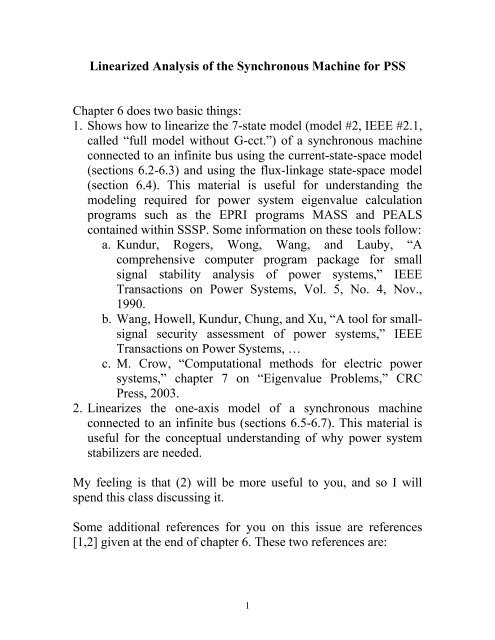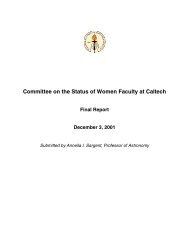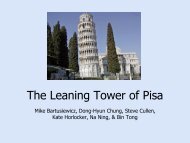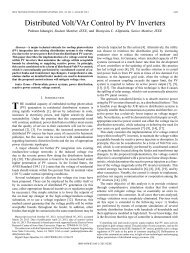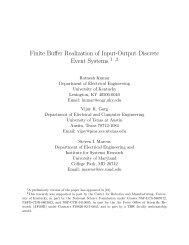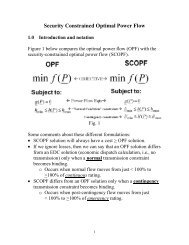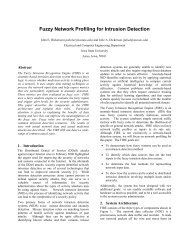Linearized Analysis of the Synchronous Machine for PSS Chapter 6 ...
Linearized Analysis of the Synchronous Machine for PSS Chapter 6 ...
Linearized Analysis of the Synchronous Machine for PSS Chapter 6 ...
Create successful ePaper yourself
Turn your PDF publications into a flip-book with our unique Google optimized e-Paper software.
<strong>Linearized</strong> <strong>Analysis</strong> <strong>of</strong> <strong>the</strong> <strong>Synchronous</strong> <strong>Machine</strong> <strong>for</strong> <strong>PSS</strong><br />
<strong>Chapter</strong> 6 does two basic things:<br />
1. Shows how to linearize <strong>the</strong> 7-state model (model #2, IEEE #2.1,<br />
called “full model without G-cct.”) <strong>of</strong> a synchronous machine<br />
connected to an infinite bus using <strong>the</strong> current-state-space model<br />
(sections 6.2-6.3) and using <strong>the</strong> flux-linkage state-space model<br />
(section 6.4). This material is useful <strong>for</strong> understanding <strong>the</strong><br />
modeling required <strong>for</strong> power system eigenvalue calculation<br />
programs such as <strong>the</strong> EPRI programs MASS and PEALS<br />
contained within SSSP. Some in<strong>for</strong>mation on <strong>the</strong>se tools follow:<br />
a. Kundur, Rogers, Wong, Wang, and Lauby, “A<br />
comprehensive computer program package <strong>for</strong> small<br />
signal stability analysis <strong>of</strong> power systems,” IEEE<br />
Transactions on Power Systems, Vol. 5, No. 4, Nov.,<br />
1990.<br />
b. Wang, Howell, Kundur, Chung, and Xu, “A tool <strong>for</strong> smallsignal<br />
security assessment <strong>of</strong> power systems,” IEEE<br />
Transactions on Power Systems, …<br />
c. M. Crow, “Computational methods <strong>for</strong> electric power<br />
systems,” chapter 7 on “Eigenvalue Problems,” CRC<br />
Press, 2003.<br />
2. Linearizes <strong>the</strong> one-axis model <strong>of</strong> a synchronous machine<br />
connected to an infinite bus (sections 6.5-6.7). This material is<br />
useful <strong>for</strong> <strong>the</strong> conceptual understanding <strong>of</strong> why power system<br />
stabilizers are needed.<br />
My feeling is that (2) will be more useful to you, and so I will<br />
spend this class discussing it.<br />
Some additional references <strong>for</strong> you on this issue are references<br />
[1,2] given at <strong>the</strong> end <strong>of</strong> chapter 6. These two references are:<br />
1
[1] W. Heffron and R. Phillips, “Effect <strong>of</strong> modern apllidyne<br />
voltage regulators on under-excited operation <strong>of</strong> large turbine<br />
generators,” AIEE Transactions, pt. III, vol. 71, pp. 692-696, 1952.<br />
[2] F. de Mello and C. Concordia, “Concepts <strong>of</strong> synchronous<br />
machine stability as affected by excitation control,” IEEE<br />
Transactions on Power Apparatus and Systems, PAS-88, pp 316-<br />
329, 1969.<br />
Reference [1] came first and produced what is commonly referred<br />
to in <strong>the</strong> literature as <strong>the</strong> Heffron-Phillips model <strong>of</strong> <strong>the</strong><br />
synchronous machine. Reference [2] extended <strong>the</strong> Heffron-Phillips<br />
model and is <strong>the</strong> most well known. Reference [2] is also viewed as<br />
<strong>the</strong> seminal work that motivated <strong>the</strong> need <strong>for</strong> power system<br />
stabilizers (<strong>PSS</strong>). This paper is on <strong>the</strong> web site <strong>for</strong> you to<br />
download, read, and place in your notebook. You will note that it<br />
contains material quite similar to what follows below.<br />
Your text also provides background on this issue in several<br />
separate locations, found in <strong>the</strong> following sections:<br />
• Section 3.5.1: Voltage regulator with one time lag<br />
• Section 6.5: Simplified linear model<br />
• Section 6.6: Block diagrams<br />
• Section 6.7: State-space representation <strong>of</strong> simplified model<br />
• Section 7.8: State-space description <strong>of</strong> <strong>the</strong> excitation system<br />
• Section 8.4: Effect <strong>of</strong> excitation on dynamic stability<br />
• Section 8.5: Root-locus analysis <strong>of</strong> a regulated machine<br />
connected to an infinite bus<br />
• Section 8.7: Supplementary stabilizing signals<br />
I will provide <strong>the</strong> minimal analysis necessary to see <strong>the</strong> basic issue.<br />
The analysis uses <strong>the</strong> simplest model possible <strong>for</strong> which <strong>the</strong><br />
excitation system may be represented – <strong>the</strong> one-axis model (model<br />
7, IEEE #1.0), loaded through a connection to an infinite bus.<br />
2
The one-axis model is a 3-state model, developed based on <strong>the</strong><br />
following main assumptions (<strong>the</strong>re are o<strong>the</strong>rs as well – see page<br />
222):<br />
1. Only <strong>the</strong> field winding is represented (so no G-circuit and no<br />
amortisseur windings).<br />
2. dλ d /dt = dλ q /dt = 0<br />
The nonlinear equations <strong>for</strong> <strong>the</strong> one-axis model are given by eqs.<br />
(4.294) and (4.297), as follows:<br />
E&<br />
1 1<br />
'<br />
q<br />
= EFD<br />
− Eq<br />
' ' , where E<br />
q<br />
= E'<br />
q<br />
+ ( x'<br />
d<br />
−xd<br />
) I<br />
d<br />
τ<br />
1<br />
& ω = T<br />
τ<br />
& δ = ω −1<br />
j<br />
do<br />
m<br />
1<br />
−<br />
τ<br />
j<br />
τ<br />
do<br />
[ E'<br />
I + ( x'<br />
−x<br />
) I I ]<br />
q<br />
q<br />
d<br />
q<br />
d<br />
q<br />
1<br />
−<br />
τ<br />
j<br />
Dω<br />
To identify basic concepts, Concordia and deMello assumed a<br />
single machine connected to an infinite bus through a transmission<br />
line having series impedance <strong>of</strong> R e +jX e , as illustrated in Fig. 1.<br />
R e +jX e<br />
Fig. 1<br />
The generator model connected to <strong>the</strong> infinite bus can be linearized<br />
and converted to <strong>the</strong> following state-space <strong>for</strong>m, as given in eqs.<br />
(6.79) <strong>of</strong> Section 6.7:<br />
3
ΔE&<br />
'<br />
q<br />
⎛ 1<br />
= −<br />
⎜<br />
⎝ K<br />
3τ<br />
'<br />
⎛ K<br />
ω ⎜<br />
−<br />
Δ & =<br />
⎝ τ<br />
j<br />
Δ & δ =<br />
2<br />
( Δω ) ω<br />
B<br />
do<br />
⎞<br />
⎟ΔE'<br />
⎠<br />
⎞<br />
⎟ΔE'<br />
⎠<br />
q<br />
q<br />
⎛ K<br />
−⎜<br />
⎝ τ<br />
j<br />
⎛ K<br />
−<br />
⎜<br />
⎝τ<br />
'<br />
1<br />
4<br />
do<br />
⎞ ⎛ 1<br />
⎟Δδ<br />
+<br />
⎜<br />
⎠ ⎝τ<br />
'<br />
⎞ ⎛ ⎞<br />
⎟ δ ⎜<br />
1<br />
Δ + ⎟ΔT<br />
τ<br />
⎠ ⎝ j ⎠<br />
do<br />
m<br />
⎞<br />
⎟ΔE<br />
⎠<br />
FD<br />
(6.79)<br />
The LaPlace trans<strong>for</strong>m <strong>of</strong> <strong>the</strong> above equations results in <strong>the</strong><br />
following relations:<br />
K<br />
3<br />
K<br />
3K<br />
4<br />
ΔE'<br />
q<br />
=<br />
ΔE<br />
FD<br />
−<br />
Δδ<br />
1 + K<br />
3τ<br />
'<br />
d 0<br />
s 1 + K<br />
3τ<br />
'<br />
d 0<br />
s<br />
1<br />
Δω<br />
= ( ΔTm<br />
− ΔTe<br />
)<br />
sτ<br />
j<br />
(*)<br />
1<br />
Δδ<br />
= Δω<br />
s<br />
where <strong>the</strong> variables ΔE’ q , Δω, and Δδ represent LaPlace trans<strong>for</strong>ms<br />
<strong>of</strong> <strong>the</strong>ir corresponding time-domain functions. Two additional<br />
relations may be obtained as well, according to <strong>the</strong> following:<br />
ΔT<br />
e<br />
ΔV<br />
t<br />
=<br />
=<br />
K<br />
K<br />
1<br />
5<br />
Δδ<br />
+<br />
Δδ<br />
+<br />
K<br />
K<br />
2<br />
6<br />
ΔE'<br />
q<br />
ΔE'<br />
q<br />
+ DΔω<br />
(**)<br />
Finally, we note that E FD , <strong>the</strong> stator EMF produced by <strong>the</strong> field<br />
current and corresponding to <strong>the</strong> field voltage v F , is a function <strong>of</strong><br />
<strong>the</strong> voltage regulator. Under linearized conditions, <strong>the</strong> change in<br />
E FD is proportional to <strong>the</strong> difference between changes in <strong>the</strong><br />
reference voltage and changes in <strong>the</strong> terminal voltage, i.e.,<br />
Δ EFD<br />
= G<br />
e(<br />
s )( ΔVref<br />
− ΔVt<br />
) (***)<br />
where G e (s) is <strong>the</strong> transfer function <strong>of</strong> <strong>the</strong> voltage regulator.<br />
4
In <strong>the</strong> above equations (*) and (**), <strong>the</strong> various constants K 1 -K 6<br />
are defined as follows:<br />
T<br />
K = Δ e<br />
ΔTe<br />
1<br />
K<br />
Δ δ<br />
2<br />
=<br />
−1<br />
ΔE'<br />
q<br />
ΔE'<br />
K<br />
E'<br />
q = E'<br />
q<br />
4<br />
=<br />
q 0<br />
δ =δ 0 K Δδ<br />
3<br />
EFD<br />
= cons tan t<br />
K<br />
5<br />
= ΔV t<br />
Δ δ<br />
E'<br />
= E'<br />
q<br />
q 0<br />
K<br />
6<br />
=<br />
ΔV<br />
t<br />
ΔE'<br />
q<br />
δ =δ<br />
0<br />
and K 3 is an impedance factor that accounts <strong>for</strong> <strong>the</strong> loading effect<br />
<strong>of</strong> <strong>the</strong> external impedance. Your text, on pages 223, 224, and 225,<br />
provides exact expressions <strong>for</strong> <strong>the</strong>se constants <strong>for</strong> <strong>the</strong> case <strong>of</strong> <strong>the</strong><br />
one-axis model we are analyzing. Two notes:<br />
1. K 1 is <strong>the</strong> synchronizing power coefficient.<br />
2. The book expresses K 4 as (see eq. 6.60)<br />
1 ΔE'<br />
q<br />
K<br />
4<br />
=<br />
K3<br />
Δδ<br />
EFD<br />
= constant<br />
However, <strong>for</strong> K 4 and K 3 both positive constants, as is usually<br />
<strong>the</strong> case, <strong>the</strong> above expression suggests that E’ q would increase<br />
with an increase in angle (or loading). This is counter to <strong>the</strong> idea<br />
<strong>of</strong> armature reaction, where <strong>the</strong> internal flux decreases as a<br />
result <strong>of</strong> stator current. In fact, <strong>the</strong> book itself indicates as much<br />
via eq. (3.11) where it says that “K 4 is <strong>the</strong> demagnetizing effect<br />
<strong>of</strong> a change in <strong>the</strong> rotor angle (at steady-state),” which is given<br />
by <strong>the</strong> following relationship:<br />
K<br />
4<br />
1<br />
= −<br />
K<br />
limΔE'<br />
( t )<br />
t→∞<br />
3<br />
ΔvF<br />
= 0<br />
Δδ<br />
= u( t )<br />
(3.11)<br />
where we note <strong>the</strong> negative sign out front. There<strong>for</strong>e, <strong>the</strong> book<br />
expression (eq. 6.60), without <strong>the</strong> negative sign, is incorrect.<br />
5
In eq. (***), G e (s) is <strong>the</strong> transfer function <strong>of</strong> <strong>the</strong> excitation system.<br />
We do not have time to study excitation systems, but suffice it (<strong>for</strong><br />
now) to say that <strong>the</strong>re are several different kinds (DC, AC<br />
Alternator, and static), each requiring somewhat different<br />
modeling. One kind that has become quite common is <strong>the</strong> “static”<br />
excitation system, represented by Fig. 2a, where K A is <strong>the</strong> exciter<br />
gain and T A is <strong>the</strong> excited time constant.<br />
∆V ref<br />
K<br />
A<br />
1+ sT<br />
A<br />
∆E fd<br />
K F<br />
1+ sT<br />
Fig. 2a<br />
F<br />
Fig. 2a is characterized by <strong>the</strong> following transfer function.<br />
( 1 + sTF<br />
) K<br />
A<br />
Ge<br />
( s)<br />
=<br />
(****)<br />
(1 + sTF<br />
)(1 + sTA<br />
) + K<br />
F<br />
K<br />
A<br />
The static excitation is typically very fast (no rotating machine in<br />
<strong>the</strong> loop). Fast excitation response is beneficial <strong>for</strong> transient<br />
stability because generator terminal voltages see less voltage<br />
depression <strong>for</strong> less time during and after network faults. Such<br />
speed <strong>of</strong> excitation response can, however, cause problems <strong>for</strong><br />
damping, as we shall see in what follows.<br />
We may extract from <strong>the</strong> above equations (*), (**), and (***) a<br />
block diagram relation, as seen in Fig. 2. Note that in this block<br />
diagram, τ j =M.<br />
6
Fig. 2<br />
We will use this block diagram to analyze <strong>the</strong> stability behavior <strong>of</strong><br />
<strong>the</strong> machine. Although one can use a variety <strong>of</strong> methods to per<strong>for</strong>m<br />
this analysis (Root locus, Routh’s criterion, eigenanalysis), we will<br />
resort to a ra<strong>the</strong>r unconventional but quite intuitive analysis<br />
procedure that con<strong>for</strong>ms to that originally done in <strong>the</strong> deMello-<br />
Concordia paper. This analysis is based on <strong>the</strong> following<br />
observations made <strong>of</strong> <strong>the</strong> block diagram.<br />
1. ΔT d , <strong>the</strong> damping torque, is in phase with speed deviation Δω.<br />
2. ΔT s , synchronizing torque, is in phase with angle deviation Δδ.<br />
We call this synchronizing torque because <strong>the</strong> higher it is, <strong>the</strong><br />
more “stable” <strong>the</strong> machine will be with respect to loss <strong>of</strong><br />
synchronism. This is confirmed by noting that high K 1 means<br />
low loading, as indicated by <strong>the</strong> fact that K 1 is <strong>the</strong> slope <strong>of</strong> <strong>the</strong><br />
tangent to <strong>the</strong> power-angle curve at <strong>the</strong> operating point.<br />
3. Because Δδ=(1/s) Δω, we see that angle deviation lags speed<br />
deviation by 90 degrees in phase.<br />
This leads to a “stability criterion”….<br />
7
For stability, <strong>the</strong> composite electrical torque must have positive<br />
damping torque, which means that it must have a component in<br />
phase with speed deviation.<br />
So we can per<strong>for</strong>m a qualitative analysis using <strong>the</strong> following ideas:<br />
• Any electrical torque contribution in phase with angle deviation<br />
contributes positive synchronizing torque.<br />
• Any electrical torque contribution in phase with speed deviation<br />
contributes positive damping torque.<br />
Inertial torques:<br />
Let’s begin by just analyzing <strong>the</strong> “inertial” loops in <strong>the</strong> block<br />
diagram. These are <strong>the</strong> ones corresponding to D and K 1 , as<br />
indicated by <strong>the</strong> two bold arrows in Fig. 3.<br />
Fig. 3<br />
• We see that <strong>the</strong> torque contribution through D, ΔT D , is<br />
proportional to Δω so it contributes positive damping, as<br />
expected.<br />
• The torque contribution through K 1 , ΔT S , is proportional to Δδ<br />
so it contributes positive synchronizing torque, 90 degrees<br />
behind <strong>the</strong> damping torque. Figure 4 below illustrates.<br />
8
Δω axis<br />
Positive<br />
angle<br />
ΔT d<br />
ΔT I<br />
ΔT s<br />
Δδ axis<br />
Fig. 4<br />
So as long as D is positive and <strong>the</strong>re are no o<strong>the</strong>r effects, we obtain<br />
positive damping contributions from <strong>the</strong> inertial torques.<br />
Armature reaction torque:<br />
But now let’s consider <strong>the</strong> influence <strong>of</strong> armature reaction, when we<br />
get field weakening from <strong>the</strong> armature current. This effect is<br />
represented by <strong>the</strong> loop through K 4 , K 3 , and K 2 , and is represented<br />
on <strong>the</strong> diagram by ΔT ar , as indicated by <strong>the</strong> bold arrow in Fig. 5.<br />
9
Fig. 5<br />
The transfer function <strong>for</strong> ΔT ar is given by:<br />
ΔTar<br />
− K K K K K K<br />
=<br />
=<br />
Δδ +<br />
∠ −180°<br />
2 3 4 2 3 4<br />
1 + sK<br />
3τ<br />
'<br />
d 0<br />
1 sK<br />
3τ<br />
'<br />
d 0<br />
From this last transfer function, we can identify <strong>the</strong> phase <strong>of</strong> <strong>the</strong><br />
electrical torque contribution relative to Δδ, which is:<br />
−1<br />
φar = −180<br />
− tan K3τ<br />
' d0<br />
ωosc<br />
where ω osc is <strong>the</strong> frequency corresponding to <strong>the</strong> weakly damped<br />
electromechanical modes <strong>of</strong> oscillation (from 0.2 Hz up to about<br />
2.0 Hz).<br />
What does this do to <strong>the</strong> resulting torque? Since it is negative, we<br />
draw <strong>the</strong> vector with an angle measured opposite <strong>the</strong> positive<br />
angle. We clearly get -180°, but we also get an additional negative<br />
angle from <strong>the</strong> tan -1 term. Since t’ d0 ω osc is positive, this additional<br />
angle must between 0 and 90°. The effect is shown in Fig. 6 below.<br />
10
Δω axis<br />
Positive<br />
angle<br />
ΔT I +ΔT ar<br />
ΔT ar<br />
ΔT I<br />
ϕ ar<br />
Δδ axis<br />
Fig. 6<br />
Note that <strong>the</strong> effect <strong>of</strong> armature reaction on composite torque is to<br />
increase damping torque (in phase with ∆ω) and to decrease<br />
synchronizing torque (in phase with ∆δ).<br />
11
Excitation system torque:<br />
This is <strong>the</strong> electrical torque that results from <strong>the</strong> K 5 and K 6 loops,<br />
as shown in Fig. 7 below.<br />
Fig. 7<br />
This torque may be expressed based on <strong>the</strong> block diagram as:<br />
K<br />
2<br />
K<br />
3<br />
Δ Texc<br />
=<br />
Ge<br />
( s)<br />
( ΔVref<br />
− ΔVt<br />
)<br />
1 + sτ<br />
'<br />
d 0<br />
K<br />
3<br />
Ignoring ΔV ref (it represents manual changes in <strong>the</strong> voltage<br />
setting), and using (from eq. (**)):<br />
we obtain<br />
K<br />
ΔVt = K5Δδ<br />
+ K6ΔE' q<br />
K<br />
G ( s )<br />
( − K Δδ<br />
− K ΔE'<br />
)<br />
2 3<br />
ΔTexc<br />
=<br />
e<br />
5<br />
6<br />
1+<br />
sτ'<br />
d 0<br />
K3<br />
We want to express each torque as a function <strong>of</strong> ∆δ or ∆ω. But <strong>the</strong><br />
last expression has a ∆E’ q . We can address this by noticing <strong>the</strong><br />
q<br />
12
elation (from <strong>the</strong> block diagram) that ΔT exc =K 2 ΔE’ q <br />
ΔE’ q =ΔT exc /K 2 , and so we can write that<br />
K 2K<br />
=<br />
1 + sτ<br />
'<br />
3<br />
ΔTexc<br />
d 0<br />
Solving <strong>for</strong> ΔT exc yields<br />
K<br />
3<br />
G<br />
e<br />
⎛<br />
( s)<br />
⎜−<br />
⎝<br />
K<br />
5<br />
Δδ<br />
−<br />
K<br />
K<br />
6<br />
2<br />
ΔT<br />
exc<br />
⎞<br />
⎟<br />
⎠<br />
− K<br />
2<br />
K<br />
3K<br />
5<br />
Δ Texc<br />
=<br />
Ge<br />
( s)<br />
+ sτ<br />
' K + K K G ( s)<br />
1<br />
d 0 3 3 6<br />
e<br />
( Δδ<br />
)<br />
On substituting equation (****) <strong>for</strong> <strong>the</strong> static excitation transfer<br />
function G e (s), we obtain, after some algebra, <strong>the</strong> following:<br />
ΔT<br />
exc<br />
=<br />
− K<br />
(1 + sT<br />
2 3 5 A F<br />
[( )( ) ]( ) ( ) ( Δ δ )<br />
1 + sT 1 + sT + K K 1 + sτ<br />
' K + K K K 1 + sT<br />
F<br />
A<br />
F<br />
K<br />
A<br />
K<br />
K<br />
d 0<br />
3<br />
)<br />
3<br />
6<br />
A<br />
F<br />
The above relation appears quite challenging to analyze, but we<br />
can simplify <strong>the</strong> task greatly by observing that <strong>the</strong> denominator is<br />
third order. Thus, it will be possible to write <strong>the</strong> above relation as:<br />
− K<br />
2<br />
K<br />
3K<br />
5K<br />
A<br />
(1 + sTF<br />
)<br />
ΔT<br />
=<br />
( )( )( ) ( Δδ )<br />
exc<br />
s + p1<br />
s + p2<br />
s + p3<br />
where p i are <strong>the</strong> poles. We may have 3 real poles or 1 real with 2<br />
complex. In general, we express each pole as p i =σ i +jω i . Thus, <strong>the</strong><br />
transfer function becomes:<br />
ΔT<br />
exc<br />
=<br />
−<br />
3 5 A F<br />
( )( )( ) ( Δ δ )<br />
s + σ + jω<br />
s + σ + jω<br />
s + σ + jω<br />
1<br />
K<br />
1<br />
2K<br />
K K ( 1<br />
We want to evaluate <strong>the</strong> transfer function at s=jω osc , where ω osc is<br />
<strong>the</strong> frequency <strong>of</strong> oscillation <strong>of</strong> concern (we assume this frequency<br />
to be an interarea oscillation). There<strong>for</strong>e,<br />
2<br />
+<br />
2<br />
sT<br />
)<br />
3<br />
3<br />
13
ΔT<br />
exc<br />
=<br />
− K<br />
+<br />
3 5 A<br />
osc F<br />
( )( )( ) ( Δ δ )<br />
jω<br />
+ σ + jω<br />
jω<br />
+ σ + jω<br />
jω<br />
+ σ + jω<br />
osc<br />
1<br />
1<br />
2K<br />
K K ( 1<br />
osc<br />
2<br />
jω<br />
T<br />
2<br />
)<br />
osc<br />
3<br />
3<br />
On combining imaginary terms in <strong>the</strong> denominator, we get:<br />
− K2K3K5K<br />
A(<br />
1+<br />
jωoscTF<br />
)<br />
ΔTexc<br />
=<br />
σ1<br />
+ j( ω1<br />
+ ωosc<br />
) σ<br />
2<br />
+ j( ω2<br />
+ ωosc<br />
) σ<br />
3<br />
+ j( ω3<br />
+<br />
We are interested in <strong>the</strong> phase <strong>of</strong> ΔT exc relative to Δδ.<br />
( )( )( ) ( Δ δ ) ω )<br />
Fact: When <strong>the</strong> generator is heavily loaded, it is possible <strong>for</strong> K 5 to<br />
be negative. See Fig. 6.1and section 8.4.3 in your text. This makes<br />
<strong>the</strong> numerator <strong>of</strong> <strong>the</strong> previous transfer function positive.<br />
A simulation <strong>of</strong> such a case is shown in Fig. 8 below. The solid<br />
curve represents generators with fast high-gain excitation systems,<br />
but no <strong>PSS</strong>. The o<strong>the</strong>r two curves represent significantly fewer <strong>of</strong><br />
such generators.<br />
osc<br />
Fig. 8<br />
14
Repeating our transfer function:<br />
− K2K3K5K<br />
A(<br />
1+<br />
jωoscTF<br />
)<br />
ΔTexc<br />
=<br />
σ1<br />
+ j( ω1<br />
+ ωosc<br />
) σ<br />
2<br />
+ j( ω2<br />
+ ωosc<br />
) σ<br />
3<br />
+ j( ω3<br />
+<br />
Assuming K 5
and we see that <strong>the</strong> damping can go negative <strong>for</strong> fast (small T A )-<br />
high gain (large K A ) excitation systems under heavy loading<br />
conditions! And this explains <strong>the</strong> effect observed in Fig. 8.<br />
So what do we do about this?<br />
Solution 1: Limit K A to as high as possible without causing<br />
undamped oscillations. But high-gain, fast response excitation<br />
systems are good <strong>for</strong> transient (early-swing) instability! And so we<br />
would ra<strong>the</strong>r not do this.<br />
Solution 2: Provide a supplementary torque component that <strong>of</strong>fsets<br />
<strong>the</strong> negative damping torque caused by <strong>the</strong> excitation system.<br />
Basically, <strong>the</strong> idea is to push (rotate <strong>for</strong>ward) our torque vector<br />
back into <strong>the</strong> upper-right quadrant. Thus we need to phase-advance<br />
<strong>the</strong> torque vector by between 20 to 90 degrees. We will introduce a<br />
supplementary torque that does this, denoted by ΔT pss , as indicated<br />
in Fig. 10 below.<br />
Fig. 10<br />
16
The transfer function K S G lead (s) is intended to provide <strong>the</strong><br />
supplementary signal ΔT <strong>PSS</strong> as illustrated in Fig. 11 below.<br />
Δω axis<br />
Positive<br />
angle<br />
ΔT pss<br />
ΔT I +ΔT ar +ΔT exc +ΔT pss<br />
ΔT I +ΔT ar +ΔT exc<br />
Δδ axis<br />
Fig. 11<br />
We will take Δω as <strong>the</strong> feedback signal <strong>for</strong> our control loop to<br />
provide ΔT pss (we could also use angle deviation, but speed<br />
deviation is easier to obtain as a control signal).<br />
We may provide “shaping” networks to process <strong>the</strong> feedback<br />
signal in providing it with <strong>the</strong> proper amount <strong>of</strong> phase (lead or lag).<br />
For example (see Dorf, pg. 362-363), a network to provide phase<br />
lead is shown in Fig. 12.<br />
R 1<br />
C R 2<br />
V 1 V 2<br />
Fig. 12<br />
17
(One can alternatively use digital signal processing techniques.)<br />
In <strong>the</strong> phase lead network above, we get that<br />
G lead<br />
V<br />
( s)<br />
=<br />
V<br />
( s)<br />
=<br />
( s)<br />
2<br />
1<br />
R<br />
2<br />
⎧<br />
⎨R<br />
+ ⎩<br />
1<br />
R<br />
2<br />
1 ⎫<br />
⎬<br />
Cs ⎭<br />
where<br />
R<br />
1<br />
+ R2<br />
R1R2<br />
α =<br />
R<br />
, τ = C<br />
R + R<br />
2<br />
1<br />
2<br />
{ R + 1/ Cs}<br />
1<br />
1 + ατs<br />
= α (1 + τ s)<br />
Dorf shows that <strong>the</strong> maximum value <strong>of</strong> phase lead given by <strong>the</strong><br />
above network occurs at a frequency <strong>of</strong><br />
1<br />
ω =<br />
m<br />
τ<br />
α<br />
and <strong>the</strong> corresponding phase lead you get at this frequency is given<br />
by<br />
sin<br />
φ m<br />
α −1<br />
= α + 1<br />
So <strong>the</strong> idea is that you can know <strong>the</strong> frequency ω m that you want to<br />
provide <strong>the</strong> maximum phase lead. This is <strong>the</strong> frequency <strong>of</strong> your<br />
most troublesome electromechanical mode and is considered to be<br />
<strong>the</strong> <strong>PSS</strong> tuning mode.<br />
Note from <strong>the</strong> above diagram that <strong>the</strong> supplementary signal ∆T <strong>PSS</strong><br />
is actually lagging Δω, so one might think that we should provide<br />
phase lag, not phase lead, to <strong>the</strong> input signal (which is actuated by<br />
∆ω). This would in fact be <strong>the</strong> case if we could introduce <strong>the</strong><br />
“shaped” signal (<strong>the</strong> output <strong>of</strong> G lead ) directly at <strong>the</strong> machine shaft.<br />
18
However, this is not very easy to do because we cannot produce a<br />
mechanical torque directly from an electrical signal transduced<br />
from rotor speed.<br />
In fact, <strong>the</strong> only place we can introduce an electrical signal is at <strong>the</strong><br />
voltage regulator, i.e., <strong>the</strong> input to <strong>the</strong> excitation system, G e (s).<br />
This causes a problem in that we now incur <strong>the</strong> phase lag<br />
introduced by G e (s) and <strong>the</strong> τ’ d0 block, which is typically around<br />
φ exc = -80 degrees as discussed previously.<br />
So this means that we must think about it in <strong>the</strong> following way:<br />
1. We start with <strong>the</strong> Δω signal.<br />
2. We introduce a phase lead <strong>of</strong> an amount equal to X. What is X?<br />
3. We incur ~80 degrees <strong>of</strong> phase lag from φ exc .<br />
4. We provide ΔT pss lagging Δω by, say ~25 degrees. This means<br />
that X-80≈-25 degrees X=55 degrees.<br />
There<strong>for</strong>e X must be about 55 degrees. So we must provide an<br />
appropriate shaping network. This shaping network is referred to<br />
as G lead (s).<br />
There<strong>for</strong>e we can write<br />
α −1<br />
sin 55 = α + 1<br />
And solve <strong>for</strong> α.<br />
Then choose τ based on<br />
1<br />
ω =<br />
m<br />
τ<br />
α<br />
where ω m =2π(f osc ), and f osc is <strong>the</strong> frequency <strong>of</strong> <strong>the</strong> oscillation<br />
“problem mode.”<br />
19
Note <strong>the</strong> principle behind <strong>the</strong> power system stabilizer is to cancel<br />
<strong>the</strong> phase lags introduced by <strong>the</strong> excitation system with <strong>the</strong> right<br />
amount <strong>of</strong> lead compensation so that <strong>the</strong> torque exerted on <strong>the</strong><br />
shaft by <strong>the</strong> excitation control effect will be in phase with speed<br />
deviation.<br />
So <strong>the</strong> <strong>PSS</strong> introduces a supplementary signal into <strong>the</strong> voltage<br />
regulator with proper phase and gain adjustments to produce a<br />
component <strong>of</strong> damping that will be sufficient to cancel <strong>the</strong> negative<br />
damping from <strong>the</strong> exciters.<br />
20


